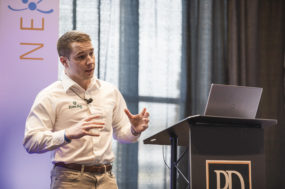First-generation dairyman Brent Copenhaver bought his first 60 cows 10 years ago, and a decade later, sound financial choices have helped him to successfully purchase his own farm and grow his operation.
As the owner of Villa Dale LLC, Copenhaver currently has 265 cows, 260 heifers and runs 350 acres of cropland in Lebanon, Pennsylvania, and he is in the process of building a brand-new barn on his very own farm after several years of renting. This is a remarkable accomplishment for a man who did not grow up on a farm or have an operation in the family to take over ownership. His achievements are the result of strategic planning, calculated decision-making and a deep-burning fire to succeed in the dairy industry.
“To build equity in cows was my number one goal, rather than land and equipment,” Copenhaver says. After purchasing his first group of cows in 2007, he later formed a partnership with a local dairyman to rent a facility and equipment, eventually buying out his partner’s half of the cows. Focusing on owning cattle helped to put him in a position of liquidity, which he felt was important because it also allowed the option of an easy exit plan should he have chosen to exit the dairy business.
That choice presented itself to Copenhaver in 2014, when the facility where he was milking did not extend the rental contract. However, he chose to stay in dairying and prioritized a few key factors to position his dairy for long-term success. Those factors included securing a market for his milk and ensuring he could get his hands on enough land to grow his own forages. A balance of work and family life was also important to him.
When Copenhaver approached a bank to obtain financing to purchase a farm and build a barn, he came well prepared. Not only did he have a building plan of exactly the setup he wanted, but he also presented balance sheets and other financial records to back it up. “I had seven years of financial records,” he notes. Copenhaver took it one step further by analyzing the numbers and coming up with three-year and five-year projected cash flows.
With approved financing, Copenhaver was able to buy land and start construction on a facility that would take his operation into the future. Should he choose to expand someday, he will be able to increase his herd size by as much as 40 percent with a second barn. Operating efficiency is a major focus, which is why he opted for a slatted floor barn with no open manure lagoon. This eliminates the need for manure scrapers and pumps that could cause challenges later on. He considered an automated milking system, but did not see that option as the best fit due to the required maintenance.
Copenhaver dedicates time to business management, with the ultimate goals of lowering debt so he can be in the best position for future opportunities and increasing milk production by improving cow comfort. He participates in livestock gross margin for dairy (LGM-Dairy), and uses crop insurance as a risk management tool.
He offers three pieces of advice to other beginning dairy producers:
- Know your financials
- Whatever you do, do the research
- Be confident in your decisions
Copenhaver looks forward to moving his cows into his very own new barn early this spring. ![]()
Brent Copenhaver was a guest speaker at the 2016 Alltech Wisconsin Dairy School on Dec. 15 in Green Bay, Wisconsin.

-
Peggy Coffeen
- Editor
- Progressive Dairyman
- Email Peggy Coffeen
PHOTO: During the 2016 Alltech Dairy School, Brent Copenhaver told other dairy producers about the steps he took to starting his own dairy. Photo courtesy of Alltech.






